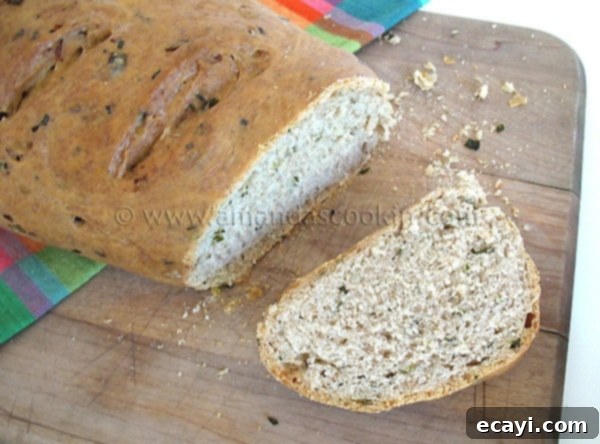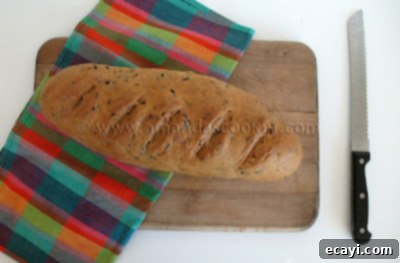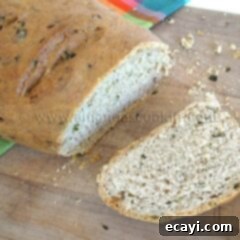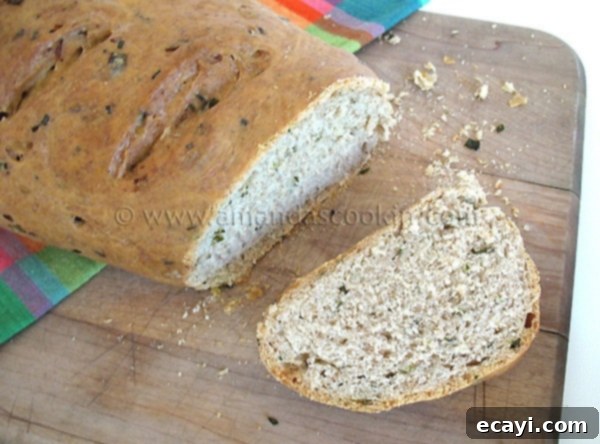Homemade Scallion Chive Bread with Garlic & Rosemary: Your New Favorite Savory Loaf

There’s nothing quite like the aroma of freshly baked bread filling your home. While summer heat often deters me from firing up the oven for extensive baking projects, a recent craving for a warm, savory loaf became an undeniable mission. I knew I needed to find a special recipe, something that would truly satisfy my desire for homemade goodness, and perhaps even fulfill an assignment for a beloved cooking club. This quest led me to create an utterly delightful Scallion Chive Bread infused with the robust flavors of garlic and rosemary, a perfect savory bread for any occasion.
The Secret Recipe Club Adventure
My inspiration for this particular baking endeavor came from The Secret Recipe Club. For those unfamiliar, it’s a fantastic online community of food bloggers, home cooks, and baking enthusiasts that I had the pleasure of founding. Each participant is secretly assigned another member’s blog, tasked with choosing a recipe to make and write about. The exciting twist? You can’t reveal your assignment or your creation until the designated “reveal day” – which just happens to be today!

My assignment for this round was Tangerine’s Kitchen, a wonderful blog run by Rachel from India. While her blog provides a glimpse into her passion for cooking and baking, much about Rachel herself remains a charming mystery. After spending some time exploring her diverse collection of recipes, I stumbled upon her intriguing Cilantro, Scallions and Garlic Bread. It immediately captured my attention, offering a unique flavor profile that promised to be both comforting and exciting.
Crafting the Perfect Savory Bread: Adaptations for Texture and Flavor
Rachel’s original recipe called for a simple blend of flour and water, which certainly yields a rustic loaf. However, for my Scallion Chive Bread, I envisioned a softer crumb and a richer, more tender texture. This led me to introduce a few key modifications to elevate the sensory experience of this homemade bread.
The Importance of Fat and Liquid in Bread Making
One of the first changes I made was adding a fat. While water-only doughs are common, incorporating an ingredient like olive oil or melted butter makes a significant difference. Fat helps tenderize the crumb, resulting in a bread that is softer to bite into, and also contributes to a beautiful golden-brown crust during baking. For this recipe, I chose extra virgin olive oil. Its bold, fruity notes wonderfully complement the savory herbs and garlic, adding an extra layer of depth to the finished loaf.
Another crucial adaptation involved the liquid. Instead of solely using water, I opted for a combination of milk and water. Milk in bread-making is a game-changer; it lends a delicate richness to the dough, promotes a finer, more even crumb structure, and contributes to a wonderfully soft crust. The lactose sugars in milk also aid in browning, giving the bread an appealing golden hue. If you prefer a milder flavor, or don’t have olive oil on hand, melted butter or a neutral oil like canola oil would work just as well, albeit with a slightly different flavor profile.
Herb Selection: Chives, Rosemary, and Garlic
While the original recipe featured cilantro, I decided to pivot based on what I had available and the flavors I was craving. I had a bounty of fresh chives and some fragrant rosemary, which seemed like an ideal pairing for a robust garlic bread. The subtle oniony notes of chives, combined with the earthy, piney aroma of rosemary, create a sophisticated and incredibly aromatic profile that perfectly complements the pungent garlic and fresh scallions. This combination yields a truly distinctive savory bread that’s both comforting and exciting.
Baking for Perfection: Knowing When Your Bread is Done
Rachel’s recipe wisely instructed to bake until “done,” a common but sometimes ambiguous term for new bakers. This highlights a crucial aspect of baking: internal temperature is your best friend. Relying solely on visual cues can be misleading, as breads can look perfectly golden on the outside but still be undercooked within. For yeast breads, an internal temperature between 185°F and 200°F (85°C to 93°C) typically indicates doneness. I find aiming for the higher end of this range usually guarantees a well-cooked, flavorful loaf with a crispier crust. A simple instant-read thermometer inserted into the center of the loaf will give you an accurate reading and eliminate any guesswork.
The combination of bold rosemary and rich olive oil truly shone in the final Scallion Chive Bread, delivering a robust and intensely aromatic flavor that I absolutely adored. If you prefer a more subtle profile, you could easily experiment with milder herbs like thyme or even a touch of dried dill, and pair it with a less assertive oil. The beauty of homemade bread lies in its adaptability!
Why You’ll Love This Scallion Chive Bread
This Scallion Chive Bread with Garlic and Rosemary isn’t just a side dish; it’s a star in its own right. Here’s why it’s destined to become a staple in your kitchen:
- Unforgettable Flavor: The blend of fresh scallions, delicate chives, fragrant rosemary, and pungent garlic creates a symphony of savory notes that is truly addictive. It’s herbaceous, aromatic, and deeply satisfying.
- Perfect Texture: Thanks to the inclusion of milk and olive oil, this bread boasts a tender, fluffy interior contrasted beautifully with a delightfully crisp, golden-brown crust.
- Versatile Pairing: It’s an excellent accompaniment to a variety of meals, from hearty soups and stews to grilled meats or a simple pasta dish. It also makes an incredible base for sandwiches or a flavorful morning toast.
- Aromatic Experience: The process of baking this bread fills your home with an irresistible aroma that is almost as rewarding as eating it. It’s pure comfort.
- Relatively Simple to Make: While bread baking can seem daunting, this recipe is straightforward and rewarding, even for those with limited bread-making experience. The stand mixer does most of the heavy lifting!
Tips for Perfect Garlic Rosemary Bread Every Time
Achieving a perfect loaf of homemade bread is incredibly rewarding. Here are a few extra tips to ensure your Scallion Chive Bread turns out beautifully:
- Yeast Activation: Ensure your lukewarm water is the right temperature (around 105-115°F or 40-46°C) for activating the yeast. If it’s too cold, the yeast won’t activate; too hot, and it can kill it. The frothing is a good sign that your yeast is alive and well.
- Dough Consistency: Don’t be afraid if the dough is a bit sticky after initial mixing. That stickiness often translates to a moist, tender crumb in the final bread. Lightly floured hands and a dusted counter will help manage it during kneading.
- Kneading is Key: Proper kneading develops the gluten, giving the bread its structure and chewiness. If using a stand mixer, let it work the dough until it’s smooth and elastic. If kneading by hand, aim for a similar smooth, pliable texture.
- Proofing Environment: A warm, draft-free place is ideal for rising dough. If your kitchen is cool, you can place the bowl in a slightly warmed (turned off) oven or near a sunny window.
- Don’t Skimp on the Herbs & Garlic: The generous amounts of scallions, chives, garlic, and rosemary are what give this bread its signature flavor. Use fresh ingredients for the best results.
- Internal Temperature Check: As mentioned, use an instant-read thermometer. It’s the most reliable way to confirm your bread is thoroughly baked without drying it out.
This Scallion Chive Bread with Garlic and Rosemary is more than just a recipe; it’s an experience. From the moment the yeast begins to bubble to the final, fragrant slice, you’ll be captivated by the process and thrilled with the results. It’s a testament to the simple joys of homemade food and the delightful discoveries that come from culinary adventures, especially when shared with a community like The Secret Recipe Club.

Scallion Chive Bread with Garlic and Rosemary
IMPORTANT – There are often Frequently Asked Questions within the blog post that you may find helpful. Simply scroll back up to read them!
Print It
Pin It
Rate It
Save ItSaved!
Ingredients
- 2 ½ cups bread flour
- 1 ½ cups whole wheat flour
- 1 teaspoon salt
- 1 tablespoon SAF instant yeast
- 2 tablespoons honey
- ¼ cup lukewarm milk
- 1 ¼ cups room temperature water
- 3 tablespoons olive oil
- ¼ cup chopped fresh chives
- 1 teaspoon minced fresh rosemary
- 2 scallions chopped
- 4 cloves garlic chopped
- Fresh ground pepper to taste
- 1 tablespoon unsalted butter
Instructions
-
Dissolve the yeast and honey in the warm water. Allow it to froth for about 10-15 minutes.
-
Meanwhile, whisk the flours together with the salt. Make a well in the center of the dry ingredients and add the yeast mixture, the olive oil, and the water. Using a dough hook combine the ingredients until a soft dough is formed. Dough might be a little sticky to the touch.
-
Lightly dust counter and your hands with flour. Knead the dough for about 5 minutes. Place dough into a greased bowl. Cover with a towel and let rise until doubled, about an hour.
-
Combine garlic, scallions, chives, rosemary, and about 5 or 6 turns of freshly ground black pepper in a small bowl.
-
Punch the risen dough down and add in herb mixture. Knead all the ingredients together well. Cover and allow to rise again until doubled, about an hour.
-
Preheat your oven to 400 F. Punch down dough and press into a rectangle, about 14″ x 6″. Roll the rectangle up and pinch the seam together. Place loaf onto insulated baking sheet, seam side down. Use a sharp knife to cut several 1/4″ deep slits diagonally into loaf. Bake in preheated oven for 40-45 minutes (mine was 43).
-
Remove from oven and let cool on a wire rack.
Nutrition
The recipes on this blog are tested with a conventional gas oven and gas stovetop. It’s important to note that some ovens, especially as they age, can cook and bake inconsistently. Using an inexpensive oven thermometer can assure you that your oven is truly heating to the proper temperature. If you use a toaster oven or countertop oven, please keep in mind that they may not distribute heat the same as a conventional full sized oven and you may need to adjust your cooking/baking times. In the case of recipes made with a pressure cooker, air fryer, slow cooker, or other appliance, a link to the appliances we use is listed within each respective recipe. For baking recipes where measurements are given by weight, please note that results may not be the same if cups are used instead, and we can’t guarantee success with that method.
